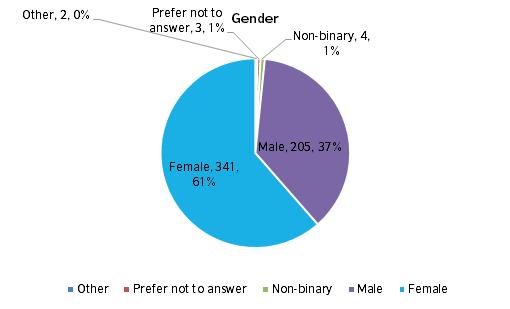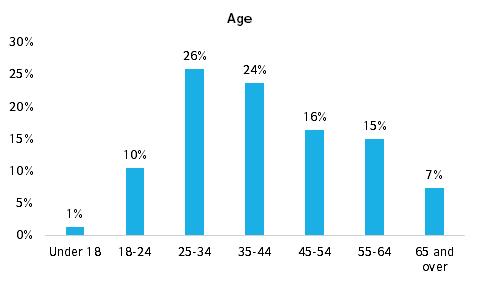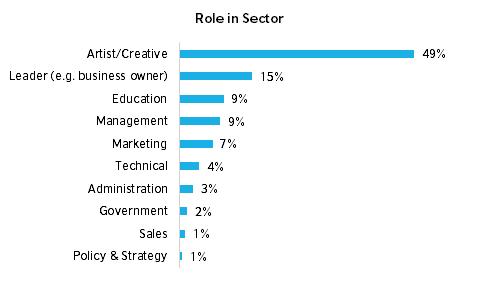
14 minute read
3. The Cultural and Creative Industries
Jamaica has a rich and enviable tradition of the cultural and creative industries (CCIs) that has evolved in a historical context largely based on the narrative, celebration, protest and affirmation of its people, culture, and way of life. It is known resoundingly across the globe for its music, dance and folklore, and for giving birth to some of the most recognisable genres across the globe including reggae and dub. The ‘brand Jamaica’ was born out of Jamaica’s strong tradition of culture and yields tremendous potential for the nation as a whole, which also serves as one of the country’s greatest foreign exchange earning potentials.25
Advertisement
There is a need for verification of the contribution of CCIs to Jamaica’s economy. According to UNESCO, Jamaica’s cultural and creative industries’ (CCIs) are estimated to contribute 5.2% of the country’s GDP, generating revenues of JMD $2.2 billion annually, and accounting for 3% of total employment.
The feedback from consultations during this mapping exercise suggested that these figures were low, particularly in light of the informal nature of many aspects of these industries. This informality is pervasive, however the economic impact is visible, whether through major festivals such as Rebel Salute and Reggae Sumfest to smaller events such as “round robins”. Activities such as “Round Robins” contribute significantly to the livelihood of persons in many low-income communities across Jamaica. These are events that are held as an organised activity over a set period of time, in which hosts pool funds and rotate the venue for the event, over consecutive days/weekends to a location determined by each participating host. The hosts and their network attend all the events supporting and ensuring success and a good financial return for each participating host.
There is an urgent need to research and document the economic impact of CCIs in Jamaica with a population of just under 3 million people, Jamaica’ GDP of JMD $2.4 trillion had a growth rate of 1.7% and a trade deficit of JMD 718 billion in 2019.26 Jamaica’s greatest merchandise exports are food items, with a vast majority of trade going to the US. The Planning Institute of Jamaica estimated the ‘Other Services Industry’ – of which the Recreational, Cultural and Sporting Activities (RCS) sub-industry accounts for the largest share – recorded an increase of 0.9 per cent in Real Value Added’ in 2018. 27
The Jamaica’s Cultural and Creative Industries in the Global Context
Globally, the world’s cultural and creative industries generate US$2.3 trillion in annual revenues and employ 1% of the worldwide population. 28Latin America and the Caribbean account for US$124 billion of these revenues, employing an estimated 1.9 million people in total.29 In both developed and developing economies alike, the CCIs have accelerated regional growth by leveraging the talent, creativity and innovation of their people, generating high quality jobs, and increasing productivity and exports. They have also provided a resounding opportunity for social impact and inclusive growth.
The CCIs in Jamaica have a prominent role in the economy and present a highly promising future. Presenting a significant untapped potential, as demonstrated in other countries, the CCIs are experiencing a high and sustained growth rate that has surpassed other more traditional sectors globally. The size of the global market for creative goods more than doubled in size from 2002 to 2015, with an average growth rate exceeding 7%.30 Between 2003 and 2012, exports alone of creative goods grew by 68% across
25 Fleming, ‘Prioritisation Paper: Development of a Business Plan for the Caribbean Creative Industries Management Unit’, Caribbean Development
Bank, 2016. 26 UNCTAD, Jamaica Country Profile, 2019. https://unctadstat.unctad.org/CountryProfile/GeneralProfile/en-GB/388/index.html 27 Planning Institute of Jamaica, ‘Economic & Social Survey Jamaica’, 2018 28 EY, ‘Cultural Times: The First Global Map of the Cultural and Creative Industries’, UNESCO, 2015. https://en.unesco.org/creativity/sites/creativity/ files/cultural_times._the_first_global_map_of_cultural_and_creative_industries.pdf. 29 Ibid. 30 United Nations, ‘Creative Outlook: Trends in international trade in creative industries 2002-2015’, UNCTAD, 2018.
developing economies.31 In the UK, the CCIs grew more than five times faster than the national economy, generating over 3 million jobs (accounting for one in 11 UK jobs) and contributing over GBP £111 billion in GVA (equivalent to £306 million per day).32 Meanwhile, the UK’s CCI services sector generated over £35 billion in exports, with a growth rate of 8.9%, accounting for 12% of the UK’s national services exports.33
The global visual arts, music, and books CCI sectors employed the most people in 2013, while the television, visual arts, and newspaper/magazines sectors recorded the highest revenues.34 In the Latin America and Caribbean region much of these rankings remain true, with the visual arts, architecture, and book sectors accounting for the highest levels of employment among all other CCI sectors and the television, advertising, and newspaper/magazine sectors leading all other CCI sectors in revenue generation in 2015.35
Jamaica has a strength in global creativity ranking 72nd among 131 economies on the WIPO Global Innovation Index (GII), outperforming Peru, Argentina, Dominican Republic and Trinidad and Tobago but below Colombia and Brazil.36 The Jamaican Creative Output sub-index scored 30.0, ranking 42nd globally, outperforming Mexico, Costa Rica and Panama.37
Jamaica ranked 80th out of 141 economies on the World Economic Forum’s Global Competitiveness Index, which ranks the policies, support mechanisms, institutions, and other factors that encourage productivity and sustainable economic development in the short to medium horizons of the world’s economies.38 On this index, Jamaica outperformed Argentina, Honduras, Haiti and Guatemala while following very close behind the Dominican Republic and Trinidad and Tobago.39
31 UNCTAD, Global Database on Creative Economy, Beyond 20/20 WDS - Table view - Exports and imports of creative services, annual, 2003-2012 (Discontinued) (unctad.org). 32 DCMS, ‘DCMS Sectors Economic Estimates 2018: GVA’, 2020. 33 Ibid. 34 EY, ‘Cultural Times: The First Global Map of the Cultural and Creative Industries’, UNESCO, 2015. https://en.unesco.org/creativity/sites/creativity/ files/cultural_times._the_first_global_map_of_cultural_and_creative_industries.pdf. 35 Ibid. 36 Cornell INSEAD WIPO, ‘Global Innovation Index 2020: Jamaica’, 2020, https://www.globalinnovationindex.org/analysis-economy. 37 Ibid. 38 Schwab, ‘The Global Competitiveness Report 2019’, World Economic Forum, 2019. http://www3.weforum.org/docs/WEF_
TheGlobalCompetitivenessReport2019.pdf. 39 Ibid.
Scoping and defining the cultural and creative industries in Jamaica has incorporated international standards from UNESCO, CARICOM, the UK Department for Digital, Culture, Media, and Sport (DCMS). Each of these institutions approach the definitions and taxonomies of the cultural and creative industries in nuanced ways. The Jamaican Ministry of Culture, Gender, Entertainment and Sport (MCGES) has operated with a broad and inclusive approach, characterized as the Entertainment, Culture and Creative Industries (ECCIs). The ECCIs comprise the sport and gastronomy/culinary arts alongside music, visual and performing arts, film and TV, publishing, digital media, events, fashion and intellectual property rights.
Based on a review of international standards from MCGES, CARICOM, UNESCO, and the UK’s DCMS, and insight gleaned from research and consultation with Jamaican CCI stakeholders, a Jamaican model was developed for this study. Recognising the distinction between each sector is distinct, it is important to note that many practitioners often work across multiple sectors and may not identify themselves as working within such a framework. The sector composition of Jamaica’s CCIs for the scope of this study is depicted in the graphic below.
Figure 2: Cultural and Creative Industries definition Framework for Jamaica
Jamaica Ministry of Culture, Gender, Entertainment & Sport CARICOM
UK Department for Digital, Culture, Media & Sport Jamaica’s Cultural and Creative Industries
1. Music, Entertainment
Industry, Publishing &
Literary 2. Architecture & Design 3. Art, Craft, Antiques & Fine
Arts 4. Audio-Visual, Him, Video,
Media Arts, Animation,
Broadcasting, Advertising 5. Performing Arts,
Theatre 6. Fashion, Fashion Industry 7. Culinary/Gastronomy 8. Sports 9. Tools of Trade 1. Arts & Culture: Performing
Arts, Visual Arts, Literary
Arts, Photography,Craft,
Culinary Ms, Libraries,
Museums, Galleries,
Archives, Heritage Sites,
Festivals, Arts Supporting
Enterprises 2. Design-. Advertising,
Architecture, Web &
Software Design, Graphics,
Industrial Design, Fashion,
Communications, Interior &
Environmental Design 3. Media: Broadcasting (includes P1, Radio &
Cable), Digital Media (includes Software &
Computer Services), Film & ‘Video, Recorded Music,
Publishing, Video Games 4. Cultural Heritage:
Immovable Sites,
Intangibles, Natural Sites,
Underwater Sites 1. Advertising &
Marketing 2. Architecture 3. Crafts 4. Design: Product, Graphic &
Fashion 5. Him, TV, Video, Radio &
Photography 6. IT, Software & Computer
Services 7. Publishing 8. Museums, Galleries & libraries 9. Music, Performing Visual
Arts 1. Music 2. Literature &
Publishing 3. Visual Arts 4. Design, Gifts & Crafts 5. Film 6. Television & Broadcast 7. Digital Media 8. Advertising &
Marketing 9. Theatre, Dance &
Performing Arts 10. Fashion 11. Culinary/Gastronomy 12. Museums, Galleries &
Libraries 13. Cultural Heritage
UNESCO
1. Cultural & Natural Heritage 2. Performance and
Celebration 3. Visual Arts & Crafts 4. Books & Press 5 Audio-
Visual &
Interactive Media 6. Design & Creative
Source: Nordicity analysis, UNESCO, Jamaica Ministry of Culture, CARICOM, British Council, DCMS
Jamaica’s cultural and creative industries comprise an ecosystem of stakeholders, including artists, employees, freelancers, entrepreneurs, companies & enterprises, associations & industry representation bodies, educational institutions, and government.
Government support and oversight of Jamaica’s CCI sectors administered across a myriad of ministries and departmental agencies. The fragmentation of cultural policy and strategy is overseen by as many as 9 bodies, including not only the departments of culture but also those of tourism, commerce, education, the office of the prime minister, amongst others, each with oversight of different elements of the sector’s value chain.
Each ministry and departmental agency oversees separate agencies on an as needed basis to manage certain regulatory or developmental activities. For example, the Jamaica Business Development Corporation (JBDC) was established in 2001 as an agency of the Ministry of Industry, Commerce, Agriculture and Fisheries (MICAF), to provide micro, small, and medium-sized enterprises (MSMEs) with business training and development services and manage the authentic retailer, Things Jamaican.
The sector is represented by a growing number of industry associations, guilds, and societies who represent the interests of their specific CCI sectors. These associations carry various responsibilities from advocacy to training, to the negotiation to obtain and dispersal of commissions from the licensing and use of Jamaican creator’s works in different markets.
There also exists a small number of institutions and agencies which operate in a hybrid model that both support the social aspects of Jamaica’s CCIs while also encouraging entrepreneurship and professional growth, such as Kingston Creative.
At the core of the cultural and creative industries are the artists, creatives, creative businesses and not-for-profits that work within them. These comprise both individuals and organisations including businesses, entrepreneurs, freelancers, self-employed artists, and creatives who create Jamaica’s CCI products and services. These stakeholders exist in various forms and sizes, with a high proportion of freelancers/independent artists noted across Jamaica’s CCIs.
Enterprises & Individuals
• Individual Artists & Creatives • Individual Freelancers & Entrepreneurs • Individual Employees & Workers • Businesses & Enterprises • Charities • Not-for-profits
Policy, Government, Ministries & Departmental Agencies
• Companies Office of Jamaica • Development Bank of Jamaica (DBJ) • Entertainment Advisory Board (EAB) • Jamaica Broadcasting Commission • Jamaica Business Development Corporation (JBDC) • Jamaica Creative / National Cultural and Creative Industries Council (NCCI) • Jamaica Cultural Development Commission • Jamaica Film Commission • Jamaica Intellectual Property Office (JIPO) • Jamaica Promotions Corporation (JAMPRO) • Ministry of Culture, Gender, Entertainment and Sport • Ministry of Education, Youth and Information • Ministry of Industry and Commerce • Ministry of Tourism • National Export-Import Bank of Jamaica (EXIM Bank) • Statistical Institute of Jamaica (STATIN) • The Planning Institute of Jamaica (PIOJ) • Ministry of Education, Corporate Jamaica, and Cultural Community Groups • National Library of Jamaica (NLJ)
Associations and Representative Bodies
• Advertising Agencies Association of Jamaica (AAAJ) • Association Caribbean Copyright Societies (COTT) • Association of Copyright Caribbean Societies (ACCS) • Association of Copyright Caribbean Societies (ACCS) • Book Industry Association of Jamaica (BIAJ) • Jamaican Copyright Licensing Agency (JAMCOPY) • Designers Guild • eSports Jamaica • Jamaica Animation Nation Network (JANN) • Jamaica Anti-Piracy Alliance (JAPA) • Jamaica Association of Composers, Authors & Publishers Limited (JaCAP) • Jamaica Association of Villas & Apartments (JAVA) • Jamaica Association of Vintage Artistes & Affiliates (JAVAA) • Jamaica Design Association (JDA) • Jamaica Federation of Music (JFM) • Jamaica Federation of Music and Affiliates Union (JFMAU) • Jamaica Performers Administration Society (JPAS) • Jamaica Film & Television Association (JAFTA) • Jamaica Football Federation Ltd. (JFF) • Jamaica Guild of Artists • Jamaica Hotel and Tourism Association (JHTA) • Jamaica Music Society (JAMMS) • Jamaica Sound System Federation • Jamaican Association of Dance and Drama Educators (JADDE) • Jamaican Institute of Architects (JIA) • Jamaican Writers Society (JaWS) • Premier League Clubs Association (PLCA) • The Jamaica Reggae Industry Association (JaRIA) • Visual & Performing Arts Jamaica (VPAJ) • Jamaica Wood Products And Furniture Association
Educational Institutions
• Creative Production and Training Centre • Edna Manley College of the Visual and Performing Arts • iCreate Institute – University of the Commonwealth • Northern Caribbean University • University of Technology • University of West Indies (Caribbean School of Media and Communication) • Vocational Training Development Institute • HEART/NSTA Trust • Excelsior Community College
International Partners
• British Council • Carib Export • Caribbean Development Bank (CDB) • CARICOM • CARIFORUM • Inter-American Development Bank (IDC) • UNCTAD • UNESCO • UNDP • USAID • World Banks • World Intellectual Property Office (WIPO) • Commonwealth Secretariat
The Jamaica Business Development Corporation (JBDC) is Jamaica’s premier business development organisation. Established in 2001 as an agency of the Ministry of Industry, Commerce, Agriculture and Fisheries, the JBDC is committed to pursuing programmes and policies that foster development, sustainability, modernization and growth in the Micro, Small and Meduim-size Enterprise (MSME) sector. Over the years, the JBDC has offered solutions and capacity building to Jamaica’s MSME’s including training, project management, market development and access and more. They also offer technical and business incubation support through their Incubator and Resource Centre (IRC).
The Jamaica Business Development Corporation has been a long-time ally and supporter of Jamaica’s Cultural and Creative Industries. They have been a leading force in developing and promoting “Brand Jamaica” in both regional and international domains, in part through their leadership of the authentic Jamaican retailer, Things Jamaica.
The JBDC has taken many actions in 2020 to further support the myriad of subsectors that make up Jamaica’s CCIs. In early March, the JBDC launched a website and eCommerce platform for Things Jamaica, widening the retail chain’s market to include direct-to-customer international sales. Through summer 2020, the JBDC hosted a batch of weekly webinar series’ to provide training to entrepreneurs, MSMEs, and CCI sector practitioners remotely. Their ‘JBDC In Concert’ series launched in March 2020 and featured weekly presentations and panel discussions on topics of interests to Jamaica’s various CCI subsectors. Business training workshops were provided weekly through the ‘JBDC Virtual Biz Zone’ series. Topics included how to manage businesses through a crisis, how to build careers in the arts, and business commerce solutions among many more. A separate Virtual Biz Zone series was created for practitioners in the Gifts & Crafts sector, presenting training on topics specific to businesses in this domain.
Marking a continuous commitment to defining, understanding, and strengthening Jamaica’s Cultural and Creative Industries, in January of 2020 the Jamaica Business Development Corporation in partnership with the British Council, commissioned Nordicity to put together the first ever mapping of these sectors, marking a first step towards economically defining the value of this industry. Further projects, including an economic impact analysis of the CCIs, are planned for the coming years.
3.1 Profile of Jamaica’s Cultural and Creative Industry Members
Jamaica’s CCIs are comprised of a vast and varied population of creatives, freelancers, SMEs, microenterprises, workers and support bodies. Nordicity’s survey of over 550 CCI stakeholders reflects a workforce of creative business owners, artists, freelancers and workers from across the country, providing some insight into the composition of the CCIs.
Respondents to the Nordicity survey had higher responses from the visual arts, performing arts, design, and music sectors, and fewer from the culinary/gastronomy and museums, galleries and libraries sectors. The distribution of responses across Jamaica’s CCI sectors are presented in the chart below.
Source: Nordicity Survey 2020. Sample: n=556. Note: Multiple choices available.
Nordicity’s survey comprised responses from 178 business owners and entrepreneurs (32% of respondents), 142 individual artists (25%), 127 freelancers (23%), 54 government workers (10%), 39 employees (7%), 9 industry association leaders (2%) and 8 industry association workers (1%).

Source: Nordicity Survey 2020. Sample: n=557
A majority of cultural and creative industry respondents to the Nordicity survey identified as female (61%). Over one-third of respondents identified as male (37%), whilst a minority identified as non-binary, preferred not to answer, or other (2%).

Source: Nordicity Survey 2020. Sample: n=555
Jamaica’s cultural and creative industries are relatively mixed in age. Half of the respondents to the Nordicity survey were between the ages of 25-44 years old (50%), whilst 38% were above the age of 45, and 11% were under the age of 24.

Source: Nordicity Survey 2020. Sample: n=556
Jamaica’s cultural and creative industries are comprised of a large proportion of individual artists and creatives. Approximately half of the respondents to the Nordicity survey were individual artists or creatives (49%). Industry leaders such as creative business owners represented 15% of respondents, followed by education (15%), management (9%), marketing (7%), technical (4%), administration (3%), government (2%), and sales, and policy and strategy (1% each).

Source: Nordicity Survey 2020. Sample: n=556.






